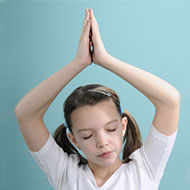- Aromatherapy (36)
- Benefits of Yoga (282)
- Home Remedies (1087)
- massage therapy (9)
- Preventive Therapy (135)
- Running (41)
- Skin Care (15)
- Stress Relief (25)
- Stretching (5)
- walking (33)
- Womens Health (14)
- Yoga Benefits for Pregnant Women (16)
- Yoga Benefits for Students (3)
- Yoga for Children (11)
- Yoga for Holistic Living (37)
- Yoga for Midlife Crisis (3)
- Yoga for Senior Citizens (2)
- Yoga for the Workplace (1)
- Yoga Health Tips (185)
- Yoga Practice during Menstruation (5)
Yoga Poses For Autism Spectrum Disorders

Autism, a formative disorder that normally develops in the first years of a child’s life, and has been rising rather worryingly since the late 1980's, Some say that the rate is as high as 1 in 500 kids. Autism was once a rare disorder, striking around one in 1500 kids. However, since the past two decades or so the rate has gone up rather sharply, both in the U.S. as well as in other parts of the world.
Autism makes it tough for kids to converse both verbally as well as non-verbally, to relate to the outside world, and to interact socially with other people, including children their age. However, many of the children afflicted by this disorder even exhibit rare abilities in other areas such as music, the arts and mathematics. Autism is characterized by a set pattern of behaviors. To any degree of severity, kids and adults could exhibit different combinations of such behaviors. So 2 kids, both afflicted by autism, might act very differently, and display varying aptitudes as well.
Fortunately, Yoga Therapy has been known to deliver highly positive results with children, reportedly improving both balance as well as sociability, together with problem solving and communication skills. Yoga believes in establishing a strong bond with the child afflicted by autism. This is the first step in teaching them anything.
Yoga For Children Suffering From Autism Spectrum Disorders
Warm up poses
- Sitting pose
- Shoulder opener pose
- Neck rolls
- Spinal rolls
- Cat pose
- Mountain pose
- Chair pose
Sitting Poses
- Butterfly pose
- (Reclining) butterfly
- Child’s pose
- Easy spinal twist
- Head to knee pose
- Seated forward bend
- Seated spinal twist
- Spread leg forward bend pose
Strengthening Poses
- Downward dog pose
- Side angle pose
- Standing forward bend pose
- Tree pose
- Triangle pose
- Warrior pose I & II
Relaxation Poses
- Boat pose
- Bridge pose
- Sphinx pose
- Stick pose
- Corpse pose
Pranayama (Breathing Exercises)
- Mild Kapalabhatti (skull cleansing)
- Anuloma-Viloma (alternate nostril breathing)
- Lion breath
- Sitkari (curled tongue cooling breath)
- Ujjayi (ocean breath)
These poses are far from easy, and the Yoga instructor needs to be able to come down to the level of children. Only then will the instructor be able to win the kid’s total, uninterrupted confidence, without which no knowledge or instruction can be imparted for healing to be possible. Music, massage, rhymes, stories and dancing are some of the additional techniques you could use to connect with the autistic child.
- RSS Feeds -
- All posts
- All comments
- Yoga to overcome eating disorders Eating disorders such as bulimia, anorexia nervosa, and compulsive eating are em...
- Yoga Breathing Techniques For Seniors Aging is a phase in which an individual has more time for oneself, family, fo...
- Yoga for Down Syndrome The ancient practice of Yoga has become popular with people all over the ...
- Does yoga have any anti-aging benefits? Yoga as a health system has been in practice for more than 5,000 years. It devel...